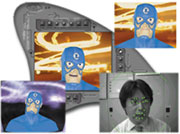The Face of the Future
Back to Contents of Issue: December 2000
|
|
|||
|
by Steve Mollman |
|||
A huge Japanese firm with over 23,000 employees worldwide, Omron makes electronic components, systems for factory automation, and way too much to list here (it started out making X-ray timers in 1933). What's relevant for this piece is that they also make the building-security swipe-cards that open office doors (and lead to the comical act of "wall-humping" by male employees around the world). Omron learned of a face-recognition technology that had been developed by a German professor and researchers from the University of Southern California, who had a startup called Eyematic Interfaces that was looking for a partner. Omron, recognizing the potential of the technology, formed a US joint venture with the professor's company. Here are some of the products that Omron has developed using the technology. • A face key. Pretty straightforward: you show your beaming mug to the camera, and, assuming your face matches up in the database, the door opens. • A face key with IC card. An "IC card" is a card with a chip that's been "integrated" onto it. In this case, the chip has your facial information stored on it. You swipe the card, the system reads which face ought be associated with that card, and if everything matches, in you go. Good for building access, yes, but also for ATMs -- and no more entering PINs! • A face-controlled screen saver. • A senility monitor system. A nursing home can set up a pedestal near the exit that has cameras hidden in it. If the face of a troublesome resident is detected leaving, nurses are notified. (Is there something creepy about that, or is it just me?) • Avatar facial control. When you move your face, an avatar onscreen imitates your facial movements. It's pretty fun to make a superhero or punk rocker smile or frown or scream in agony. Omron is thinking it'll use this application for, among other things, online customer service, where the rep can monitor the expressions of the customer. It'll also allow for an animated character to offer customer service. (Will Mickey Mouse become associated with bad service and a vacant smile?) Applications for videomail, chat, and the cellphone are in the works as well. When I asked the Omron exec if they'd use this for games and in arcades -- the first use that popped to my mind -- he lowered his lids to half-mast and said "Of course," as if I'd just asked him if Omron, like other companies in the world, use what we call "money" to make transactions. If you don't want the tech background, skip this paragraph. When you're making your initial "faceprint," the system sets approximately 50 feature points on your mug and then extracts directions, light/dark areas, positions, et cetera to create a unique data set. Later, when you try to enter a building or use your laptop or whatever, the system superimposes the aggregated feature points over the input image (that would be your face) and automatically performs inclination correction and other processes. This is definitely cool stuff, and it has the added benefit of helping to dispel the notion that big Japanese manufacturing companies are too conservative to make waves in the New Economy. Omron may not have invented this technology, but it did have the smarts to see its potential -- and the moxie to face the future.
|
|||
Note: The function "email this page" is currently not supported for this page.






